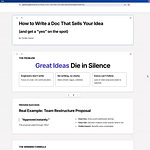This Format Doesn’t Work
The room was empty.
I logged into our last group workshop, prepped slides, cracked a coffee, and waited.
No one showed up.
And honestly? I wasn’t surprised.
We’re data people. We have jobs. Meetings. Clients. Calls. Life. Blocking time for a live call, especially one that’s not urgent, just doesn’t cut it anymore.
So I’m killing the live group coaching format.
Not the workshops themselves. Those will stay. I’ll still run them, record them, and share the good stuff. But we’re not pretending this live, synchronous thing is working. Because it’s not.
Instead, I’m shifting the format:
Workshops stay recorded. Join live if you want, but no pressure.
Coaching moves to async. You send questions, I’ll reply via posts or short videos.
Nobody’s getting less value. We’re just delivering it in a way that respects your time.
This isn’t about giving up. It’s about adapting.
And it reminded me of a weirdly perfect story from a game I started playing.
What ARC Raiders Taught Me About Running a Data Team
ARC Raiders was supposed to be a chill co-op game. Fight some aliens, loot some gear, have some fun. It launched as PvE, you vs AI. But people didn’t like it.
So the developers flipped the script. They made it PvP. They changed the entire loop based on early feedback.
And it worked.
Here’s what stuck with me: they didn’t wait until launch day to find out they were wrong.
They tested early. They watched reactions. They adjusted fast.
And I thought: holy shit, why don’t we do this more often in data?
Here are 3 hard-earned lessons from ARC Raiders that I think every data team should steal:
1. Test like it’s a game
They ran “playtests.” Small slices of the product shipped early. Not to impress people. To get answers.
We should be doing the same.
Instead of disappearing for six weeks and coming back with a giant dashboard no one asked for, slice it small. Build a mini version. Ask: “Does this help?”
MVPs aren’t deliverables. They’re decision engines. They tell you whether to keep going or turn around.
2. Pivot fast or pay later
When ARC changed formats, they didn’t stick to the original plan just because they wrote it down.
Most data teams are the opposite. We wait too long. We hard-code too much. We make it painful to change direction.
Don’t build the whole damn pipeline before showing value.
Start with a spreadsheet. One source. One chart. If it hits, build more. If it doesn’t, burn it and try again. That’s agility. That’s speed. That’s what earns trust.
3. Get buy-in before you need it
The ARC team didn’t just switch formats. They switched monetization too. People didn’t like pay-to-play. So they changed that too.
They got people invested in the game before asking them to pay more.
Data works the same way.
When I’ve grown my team in the past, it wasn’t because I made a killer case to my boss. It was because a stakeholder went to bat for me.
They saw the value early. They felt part of the journey. And when I said, “Hey, we need more headcount,” they backed it.
So co-build with stakeholders. Let them shape the thing. You’ll build better tools. And when you need more budget? You won’t be the only one asking.
Final thoughts
I never thought a half-finished online shooter would teach me more about data delivery than most tech blogs. But here we are.
That’s the thing.
Lessons come from weird places. What matters is recognizing the pattern.
So next time you launch a data project, ask yourself:
Did I test this early?
Can I pivot fast if it flops?
Is someone willing to fight for this with me?
If the answer is no, maybe you’re not building a data product.
Maybe you’re building a guess. Let’s stop guessing.
Thanks for reading,
Yordan
PS: Reach out to me. I’d love to learn what you think would make this community of data leaders great.








